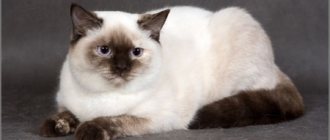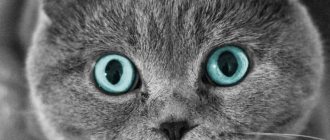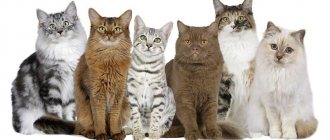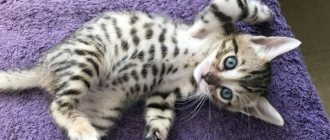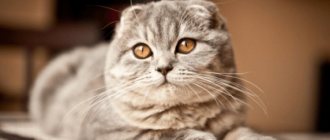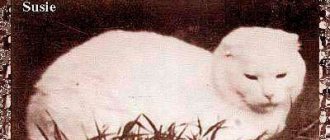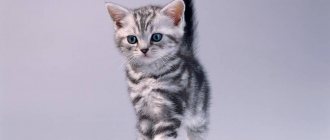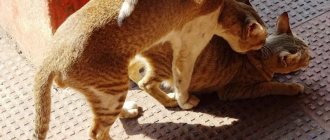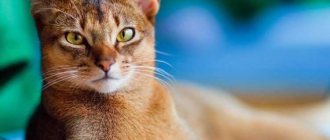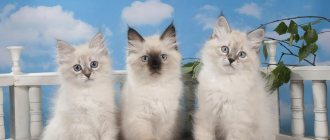Scottish cats have different colors. Scottish cats are famous because of their charming appearance and variety of colors. The color of kittens directly depends on certain genes. As a rule, these are two main shades, black and white.
Scottish Straight colors, for example, are gray with black stripes around the entire body. They are distributed as a percentage. That is, the animal’s fur is painted in two colors in different proportions. Its own gene is responsible for the dominance of one color or another.
Plain (solid, solid)
The monochrome uniform coloring of Scottish cats is considered classic by breeders. The solid or solid color of the animal implies the absolute exclusion of any inclusions, small marks and specks of a different color. The tone is rich, even along the entire length of the coat.
The most common used to be considered blue plain Scots. But today among the representatives of the breed there are many other variants of solid colors.
White
A Scottish cat with snow-white fur (without yellowness) looks luxurious. Possible eye colors are blue, amber, copper. According to the standard, eyes of different colors are allowed. The paw pads and nose are light pink.
Kittens may have markings of a different shade, which disappear after the first coat change. By the age of two, the coat of a white Scot should be crystal clear, without spots of a different color.
Black
The black cat has expressive yellow eyes. The nose and paw pads practically blend into the main color of the animal.
On the shiny bright coat of the Scottish beauty Ebony, 2-3 hairs of contrasting white color are allowed. The presence of large red or brown marks is not provided for by the standard.
Important: Scottish Fold pets are endowed with magical abilities. It is believed that it is the black color of the Scottish Fold that protects the house and its inhabitants from evil spirits.
Chocolate
The brown Scottish cat, also called chocolate, looks noble and impressive. The color of the coat contrasts with the animal's yellow, golden or copper eyes. The nose and paw pads are also dark brown.
Lilac (lavender)
The monochromatic lilac Scottish Fold has a gentle gray tint that smoothly turns into cream. The nose is slightly brownish, the paws on the bottom are the same color as the coat, in harmony with the main color of the pet. This lilac-lavender color goes well with eyes of copper, amber or orange shades.
Red (red)
Red or ginger color is a rare and valuable color of the Scots breed. The fiery edge is combined with burning amber irises. Pads and nose to match the dominant color.
The tail of kittens and adult animals is not very evenly colored. This deficiency does not disappear with age and is allowed by the standard. And the presence of marks on the head and limbs that remain after reaching the age of two are considered a deviation from the norm.
A red Scottish straight-eared cat can give birth to kittens not only with erect ears, but also with ears pressed to the head.
Cream
The cream or peach fold cat is infinitely elegant and beautiful. The delicate background of light fur, bright golden eyes and a pinkish nose give the pet an irresistible appearance. The pads on the paws are also pink. An animal with this color is similar to a red Scotsman, but its coat color is a shade lighter.
A peach fold kitten may have a blurry, fuzzy pattern on its paws and tail that does not disappear with age. This is not critical for a purebred pet, but leopard markings are absolutely unacceptable.
Faun (deer)
There is another unique color of Scottish fold cats with an interesting name - fawn, which means “young deer”. The nose and pads on the paws of these beauties are beige-pink.
Cinnamon
Cinnamon is a lighter and more delicate color than chocolate, but darker than red. The nose and paw pads of such animals are brown, beige or pink.
Blue color (blue)
The gray or blue Scottish cat has very beautiful amber eyes. The coat tone of a purebred pet can belong to any range of gray - from the lightest (blue) to completely dark (blue). At the same time, each hair is saturated and well colored, without streaks.
The nose and pads practically do not differ in color from the plain coat.
A gray Scottish Straight cat may be marked with a few streaks and drawings in childhood. But as they grow older, these color flaws go away.
Dimensions and weight
The breed has a medium sized body. Their length is approximately 55cm. Height in a standing position on fours is 30 cm.
The average Scottish Fold blue cat weighs less than an adult cat. The weight of an adult is approximately 3–5 kg, more often 3.5–4.5 kg. The cat's weight reaches 4-5 kg, sometimes 6-7 kg. The cat has a larger head and powerful paws.
Anatomical characteristics
The breed has the following characteristics:
• Round head, high forehead, strong massive chin, short wide nose, full cheeks.
• Ears curved forward and down, small to medium in size with pointed tips.
• The eyes are round, expressive, and set wide apart.
• Body of medium size, muscular neck, pronounced shoulders, developed chest.
• Limbs with small round paws and movable toes are proportional to the overall build.
• The tail is wide at the base and gradually tapers towards the tip. It is flexible and medium in size
Two-color
A unique coat color is bicolor (two-color cats). The main background is snow-white. The second color in color (cream, black, blue, red) is presented in the form of unusual patterns. Thoroughbred representatives must have white belly, neck, chest, paws, muzzle and beard.
A prerequisite is the predominance of a white background in color. Bicolors are more valued; their body patterns are symmetrical. The eyes can be any shade, but are usually blue or golden yellow.
Cream bicolor
Cute white cats with additional streaks of delicate cream tones. The eyes are blue or yellow, and the nose and pads are pink.
Blue bicolor
The pattern on the wool is blue (delicate or rich gray). The iris of the eyes is a beautiful sky tone or yellow-orange. The nose and paws below are pink.
Black bicolor
Black and white bicolor is characterized by patterns of rich black tone. These cats have a pink nose and blue or copper eyes. A symmetrical, distinct pattern on the skin turns the cat into a real gentleman in a tailcoat.
Color point
Color-point is translated from English as “colored point”. The point coloring is explained by the presence of a gene, under the influence of which the coloring of hairs intensifies in some areas of the body with insufficient blood circulation. Characteristic darkening appears on the main white or cream background of the coat.
The second name of the color is Point Links. The eye color of cats of this color is necessarily blue. Previously, this coat color was observed only in the Siamese breed. But today it is present in other cat species, including Scots.
Newborn kittens are completely white. Only by the age of one month do babies begin to show color on their ears, paws, tail and face. According to this color, several subspecies are distinguished among the points.
Blue Point
This color is characterized by a pale gray-blue, almost white shade of the body with darker, gray markings. Soft gray Scottish blue point kittens have paws and noses that match the main color.
Cream point
The body is creamy white, and the shading on the animal’s face and tail are pastel cream colors. Paw pads and nose are pink. This point color goes harmoniously with the expressive blue eyes of the cat.
Lilac Point
The dominant tone is soft white or lilac, and the markings are gray with a pink tint. The nose and paws are the same as the main color.
Seal Point
The darkest color among the points. The dominant tone is beige. Contrasting with it are brown and black markings. The same dark nose button and paw pads.
Chalklit Point
Chocolate or choclit point is distinguished by a brown pattern on a cream background. Paw pads and nose range from light cocoa to darker brown.
Red point
The main coat color is pale apricot, almost white. Darkening on certain parts of the body is red-red in color. The pads and tip of the nose are bright pink.
History of the breed
One version of the origin of the Scottish Fold cat says that it appeared in one of the Scottish villages as a result of an accidental connection between a half-wild tabby cat and an unfamiliar cat. The female kitten had a feature in the form of hanging ears, similar to folded leaves. Her offspring were distributed among friends, and thus one of the kittens ended up in the house of Mary Ross from Scotland, who was fascinated by the unusual appearance of the animal. Then she turned to specialists for advice on breeding this breed of cats.
She crossed her pet with a representative of the British Shorthair breed, and then a cat from their offspring with a British Blue cat. Thus, for the first time, the initial example of the Scottish Blue cat with drooping ears was bred.
In another version, references to this breed of representatives of the cat world date back to the 19th century in the work of Charles Darwin, where he writes about the Chinese breed of cats with floppy ears.
Tortoiseshells (torties)
The tortoiseshell color of Scottish Folds is usually tri-colored. Red, white, and black spots are located on a cream or red dominant background. When the genes of the parents are combined in a tortoiseshell kitten, these markings can take on chocolate, blue and cream shades.
When assessing tortoiseshell cats, felinologists pay attention to the even distribution of markings and the intensity of their tone. Fold-eared and straight-eared Scots with a tortoiseshell color are divided into subspecies (depending on the color scheme of the spots).
Black-red
There are black and red-red patterns all over the cat's body. The sizes and shapes of the spots are very diverse. This color is often called tortie.
Chocolate red
The patterns on the wool are brown and red. They stand out against a lighter background and look very interesting. The chocolate red color is considered rare and prized by breeders.
Blue-cream
The tortoiseshell blue-cream color in Scottish pets is determined when the main gray-blue background is covered here and there with small light cream spots.
Important: tortoiseshell coloring is characteristic only of cats. The calico cat is very rare. The appearance of a male tortoiseshell kitten indicates genetic problems. Most likely, an adult pet will not be able to have offspring, since the reproductive functions of its body are impaired.
How to choose the right kitten
If you do not know the basic characteristics of the breed, you may encounter scammers. To be sure of the breed of Scottish Blue kittens, you need to buy from certified nurseries. Not everyone has the opportunity to buy a Scotsman because they are expensive.
Signs by which you should choose fold-eared blue kittens:
- Short plush fur
- They look like little bear cubs
- Big round eyes
- Ears folded into an envelope
- When viewed from the side, the mouth resembles a smile
- The nose is neat
- Availability of pedigree and documents with vaccinations
join the discussion
Share with your friends
Almost every cat lover secretly dreams of having a pet like a Scottish Fold cat. It is perfect for both families with children and elderly people. In order to be convinced of this, you should take a closer look at the description of this breed of cats.
Smoky (smoky, tuxedo)
The color of Scottish Fold cats can be smoky. On top the coat is one color, for example black. And at the base, each hair is silvery-white. This coloring is characteristic of cats with a dominant silver gene, which creates unusual combinations of light and dark shades.
Smoky color is easy to confuse with solid color. To avoid mistakes, you just need to look at the undercoat. With a smoky color, the undercoat of a different shade is clearly visible, and with a solid color, the color of the roots does not differ from the tips.
The eyes of smoke cats are usually yellow-gold in color. Based on the shades of smoke on the fur, several subspecies of this color of animal are distinguished.
Blue smoke
Smoky blue Scottish Straights and Scottish Folds are distinguished by the color of their fur coat with a gray cold coating. But underneath the fur is white and silvery. The paw pads and nose of these pets are gray-blue.
Black smoke
This color in Scottish cats is characterized by a black edge, but the hair at the roots is white. The nose mirror and pads do not differ from the main background.
Chocolate smoke
The snow-white undercoat is combined with a brown-chocolate topcoat. The nose button and paw pads of these animals are brown in color.
Smoky Scottish Straights and Scottish Folds, despite their unique color, cannot participate in exhibitions. Such cats are not recognized by the breed standard.
History of the Blue Scots breed
Scottish fold cats appeared about 50 years ago. There are several versions of the origin.
One of them says that the animal appeared as a result of an accidental mating of a wild tabby cat and an unfamiliar cat. This is how the first fold-eared cat in the world appeared - Susie, who became the ancestor of a new breed. Scottish farmers really liked it. Susie began giving birth to kittens frequently. The owners distributed them to their friends. One farmer Mary received a kitten named Snooks as a gift. It was a semi-wild white kitten. The new owner was delighted with him. It was a girl who later also gave birth to a fold-eared kitten. Mary did not understand breeding, so she showed the baby to specialists. Felinologists became interested and developed a new breed.
Snooks and her son were crossed with a male cat and a male cat of the British breed. Their children are considered the first representatives of the Scottish breed.
There are other versions of the appearance of the Scottish Fold. In the seventies of the last century, it was forbidden to breed kittens with drooping ears, since they could not hear normally. There were other pathologies: displacement of the vertebral discs, crooked paws. Specialists had to correct the flaws. During experiments, scientists found that individuals with curved ears should only mate with straight-eared ones. As a result of such experiments, kittens with curved and protruding ears appeared.
Tabby colors
Scottish tabby cats are very popular among breed lovers. This color suggests the presence of patterns on the pet’s fur.
Depending on their shape and size, tabbies are divided into three types:
- Striped (tiger) color - the presence of clearly defined vertical stripes.
- Spotted (leopard) - the pattern is made up of spots on the animal's fur.
- Marble color is a pattern of larger chaotic marks of different shapes.
A prerequisite for tabby cats is the presence of the letter “M” on the top of the animal’s forehead. The color combinations of wool are surprising in their diversity:
- cream;
- golden;
- blue;
- marble on silver;
- black marble;
- silver;
- silver-blue.
Important: Scottish tabbies with a silver tabby color resemble the mustachioed pet from a cat food commercial. Many believe that it is the Scottish straight-eared cat with a tabby pattern that appears on the screen. This color is also called the whiskey color of Scottish cats.
Character and habits
The Scots are well-mannered, discreet, unobtrusive. Kitties are friendly with people and other pets in the house. They do not enter into conflicts and do not take revenge. If a pet is offended, it will not show aggression, but will hide alone.
Pets are quiet, they will not scream if they need something. They speak about their desires in a gentle voice. If the cat is hungry or wants attention, it will come up to its owner and purr softly, follow him and rub himself.
Individuals are phlegmatic. They love a measured, unhurried lifestyle. They like to lie on the sofa, and they are unlikely to run for a candy wrapper.
The Scots love to take care of themselves. They wash themselves and comb their fur every day. Cats keep everything clean. Their toilet should always be cleaned. A newborn blue Scottish Fold kitten is easy to litter train, but the breed is poorly trained.
The animal gets along well with children. During communication, the pet shows patience. He will not show aggression during play, will not release his claws or scratch. The cat loves his family very much. He will treat every family member well, but only one becomes a favorite.
Chinchilla
The Scottish chinchilla borrowed the extravagant colors of its coat from the British, and they, in turn, from Persian cats. A chinchilla kitten is born only from parents with an unusual color. Each hair is colored in two colors.
Most of it is light in color and 1/8 of it (the top) is dark in color. This phenomenon is called tipping.
Tipped chinchilla colors can be of 3 types:
- Golden. The cat has a white undercoat. But on top there is a reddish coating over almost the entire surface of the body (on the sides, back and tail of the animal). Only the beard, the tips of the ears and the belly are white. Yellow-gold eyes, pink pads and a brick-colored nose.
- Silver. White wool coated with silver gives an interesting gray effect. The color of the tail has a hint of stripes, the nose is beige, and the eyes are green. Snow-white tips of the pet's ears, chin and belly.
- Blue golden. The rarest and therefore valuable color of Scottish chinchillas. The undercoat is a delicate caramel color, and the tips of the hair are a radiant blue hue. The eyes are natural emeralds of a rich green tone.
Appearance care
Pedigree cats do not have very long fur, so grooming does not require special attention. Scratching them about twice a week is enough. In order to remove dead hair, you must first use a massaging brush, and then a comb with sparse and thick teeth. You need to scratch from head to tail.
It is enough to bathe your pet once a season. You need to check your ears periodically. The sulfur needs to be cleaned out. The claws need to be filed and polished. Eyes need to be checked.
To protect your animal from various problems, it is necessary to get vaccinated at a young age. The first vaccination is carried out at the age of 8 – 12 months. At the age of 5 - 7 months, teeth change; at this time, injections are prohibited.
Shaded (shedded) colors
An unusual definition refers to the interesting color of Scottish cats - shaded colors. These pets have almost white fur, but the tip of the guard hair is colored.
The top layer of a cat's coat can be any shade typical of Scottish cats. The undercoat is white. The sides, back, head, tail and ears are shaded. Light belly, chin and lower tail. There should be no obvious spots. The “M” sign on the forehead and darkish rings on the paws are acceptable.
Shedded colors can be of three varieties:
- Golden. The fur of the Scottish cat is golden, the undercoat is cream or light peach. Green eyes are very expressive and beautiful. The nose button and paw pads are chocolate.
- Red. This type of shaded color has a dark red coating on the coat with a snow-white undercoat. The eyes are amber, the pads and nose are pink.
- Silver. The white undercoat combined with the dark gray topcoat produces an amazing gray tint. Greenish eyes are lined with black stripes. This feature is typical only for the silver shedded color. Other varieties have eyes without a contour. The nose is brick-colored and the mouth is dark-lined.
